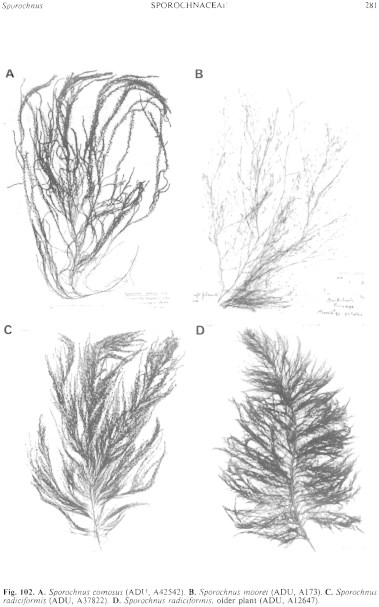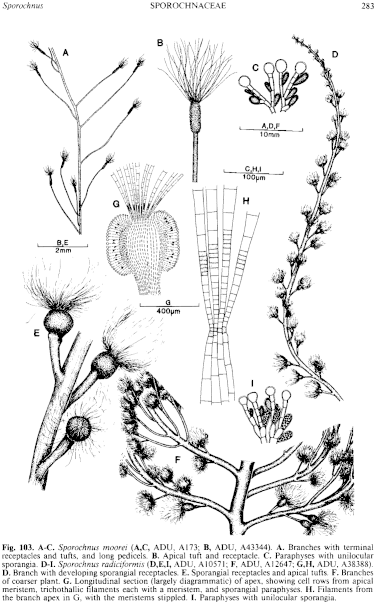|
|
|
|
|
|||||||||||
|
Electronic Flora of South Australia Species Fact Sheet
Phylum Phaeophyta – Order Sporochnales
Selected citations: Lindauer et al. 1961: 243, fig. 59 (5,6). May 1939: 197. Womersley 1967: 240.
Thallus (Fig. 102B) medium brown, 10–20 (–80) cm long, very slender throughout with one to a few percurrent axes bearing irregularly radial laterals of 2–3 orders, progressively decreasing in length, (2–) 5–20 mm apart, with each branchlet (Fig. 103A) bearing a tuft of assimilatory filaments; attachment by a rhizoidal holdfast 1–2 mm across and long; epilithic. Growth apical with a convex branch meristem surmounted by a tuft of trichothallic filaments 2–6 mm long, each with a meristem a few cells above their base, 20–35 (–40) µm in diameter above with cells L/B 2–3. Fronds slender, terete, 400–700 µm in diameter below, decreasing to 100–200 µm in diameter above, with the branchlets 2–10 (–20) mm long and (40–) 60–80 (–100) µm in diameter. Structure haplostichous and pseudoparenchymatous, with a medulla of elongate cells and a smooth-surfaced cortex of cells 4–8 (–12) µm across and L/B 3–6.
Reproduction: Sporangial receptacles (Fig. 103A,B) elongate-ovoid, becoming linear, 0.5–2 (–3) mm long and 150–250 µ in diameter, with a sterile, filiform, pedicel (0.5–) 2–10 (–20) mm long. Paraphyses (Fig. 103C) simple or branched, 70–100 µm and 6–7 cells long, with the larger terminal cell clavate to subspherical and 12–16 µm in diameter, bearing clavate sporangia (25–) 30–40 µ long and 8–12 µm in diameter.
Gametophyte unknown.
Type from "Paramatta R. estuary" (Port Jackson), N.S.W.; in Herb. Harvey, TCD (Alg. Aust. Exsicc. 51); isotypes in MEL, 15920, and NSW, A2092, A2094.
Distribution: From Spencer Gulf, S. Aust. to Port Jackson, N.S.W. New Zealand (Lindauer et al. 1961, p. 243).
Taxonomic notes: S. moorei is a very slender species with long pedicels to the sporangial receptacles, and appears to be a deep water species. The above specimens agree well with Harvey's original illustration and specimens, which were "abundant toward the eastern end of Spectacle Island"; it is very doubtful if this species now exists near the type locality. The New Zealand specimens are very similar to the Australian.
References:
HARVEY, W.H. (1858). Phycologia Australica. Vol. I, Plates 1–60. (Reeve: London.)
LINDAUER, V.W., CHAPMAN, V.J. & AIKEN, M. (1961). The marine algae of New Zealand. II. Phaeophyceae. Nova Hedwigia 3, 129–350, Plates 57–97.
MAY, V. (1939). A key to the marine algae of New South Wales. Part. II. Melanophyceae (Phaeophyceae). Proc. Linn. Soc. N.S.W. 64, 191–215.
WOMERSLEY, H.B.S. (1967). A critical survey of the marine algae of southern Australia. II. Phaeophyta. Aust. J. Bot. 15, 189–270.
The Marine Benthic Flora of Southern Australia Part II complete list of references.
Publication:
Womersley, H.B.S. (14 December, 1987)
The Marine Benthic Flora of Southern Australia
Part II
©Board of the Botanic Gardens and State Herbarium, Government of South Australia
Illustrations in Womersley Part II, 1997: FIGS 102B, 103 A–C.

Figure 102 enlarge
Fig. 102. A. Sporochnus comosus (ADU, A42542). B. Sporochnus moorei (ADU, A173). C. Sporochnus radiciformis (ADU, A37822). D. Sporochnus radiciformis, older plant (ADU, A 12647).

Figure 103 enlarge
Fig. 103. A–C. Sporochnus moorei (A,C, ADU, A173; B, ADU, A43344). A. Branches with terminal receptacles and tufts, and long pedicels. B. Apical tuft and receptacle. C. Paraphyses with unilocular sporangia. D–I. Sporochnus radiciformis (D,E,I, ADU, A10571; F, ADU, Al2647; G,H, ADU, A38388). D. Branch with developing sporangial receptacles. E. Sporangial receptacles and apical tufts. F. Branches of coarser plant. G. Longitudinal section (largely diagrammatic) of apex, showing cell rows from apical meristem, trichothallic filaments each with a meristem, and sporangial paraphyses. H. Filaments from the branch apex in G, with the meristems stippled. I. Paraphyses with unilocular sporangia.

|
Email Contact: State Herbarium of South Australia |

|